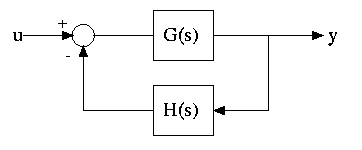|
Ch Control System Toolkit is free for academic use,
subject to
the license agreement in the
license.
It can be downloaded here.
It costs $199 for
personal or commercial use.
It is included in Ch Professional Edition for ARM (Raspberry Pi)
|
Ch Control System Toolkit
can be conveniently used
for modeling, design, and analysis of
continuous-time or discrete-time linear time invariant
(LTI) control systems.
A control system
can be modeled in the form of transfer functions
as shown in a block diagram below,
zero-pole-gain,
or state-space.
Ch Control System Toolkit
is developed in Ch Professional Edition,
with user-friendly high-level numerical and graphical plotting capabilities.

Ch Control System Toolkit supports
most classical and modern control techniques through
object-oriented programming based on a control class.
It can seamlessly interface existing C/C++ code in either source code
or binary static/dynamical libraries without re-compilation.
It can even be embedded in other application programs.
The software comes with sample code for
each member function of the control class.
If you are familiar with MATLAB® Control System Toolbox,
you may find
the following link
helpful in understanding the capabilities of Ch Control System Toolkit.
A Web-based control system design and analysis,
as a module of the
Ch Control System Toolkit,
is available for teaching and learning control theorem and practical
engineering applications. The source code
for this Web-based module is included
in the distribution of
Ch Control System Toolkit.
The users can extend it to solve many Web-based applications.
For example, a Web-based Compensator Design including source code
can be found
here.
Major Features of Ch Control System Toolkit:
-
C/C++ Compatible
Different from other similar control software
packages, programs written in
Ch Control System Toolkit can work with existing C/C++ programs and
libraries seamlessly.
-
Object-Oriented
Implemented as a C++ class,
Ch Control System Toolkit is object-oriented.
-
Cross-Platform
Developed in Ch, applications using Ch Control System Toolkit can run across
different platforms.
-
Embeddable
With Embedded Ch,
Ch programs using Control System Toolkit can be embedded
in other C/C++ application programs.
-
Web-Based
Using
the Web-based control design and analysis system
in the Ch Control System Toolkit,
design and analysis of control systems
can be performed
through the Web
using a Web browser
over the internet without
any software installation, system configuration and programming.
-
Model Building
Support multiple model representations such as
state-space models, transfer function, and zero-pole-gain
models both for continuous-time and discrete-time
linear time invariant (LTI) systems.
When a system is created using one of these three
models, the Ch Control System Toolkit automatically converts
it to other two models internally and keeps the information
of these three models for user to retrieve.
-
Continuous/Discrete Systems Conversions
Provide the capability of converting from continuous to discrete,
discrete to continuous, and discrete to discrete system.
-
System Interconnecting and Reduction
Construct arbitrary complex system models given
in a block diagram form by using interconnecting
member functions.
-
Time Domain Analysis
Compute the time responses to arbitrary inputs and
initial conditions for both SISO and MIMO systems.
The typical inputs are step and impulse inputs.
The output responses can be displayed by either a plot
or a data set.
-
Frequency Domain Analysis
Generate commonly used frequency response plots of
Bode, Nyquist and Nichols plots. Calculates the bandwidth,
DC gain, gain and phase margins of a SISO system
for system dynamics and stability analysis.
-
Root Locus Design
Calculate and plots the root locus of a SISO system.
-
Controllability and Observability
Construct the controllability and observability matrices.
Determines the controllability and observability of systems.
Calculates the controllability and observability grammians of
a state-space model.
-
State-Space Design
Find the control-law and estimator that will
allow the user to select
a set of pole locations for a satisfactory system
dynamic response.
-
Optimal Control System Design and Equation Solvers
Calculate LQ-optimal gain for both continuous and
discrete systems.
Solves continuous and discrete-time Lyapunov equations.
-
Plotting Utilities
Provide many plotting functions to allow output
visually displayed or exported as external files with a
variety of different file formats including postscript
file, PNG, LaTeX, etc. They can also readily be copied
and pasted in other applications such as Word in Windows.
|